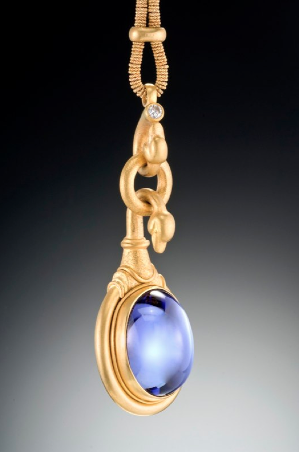Alexander Calder is one of the few artists featured in the Jewelry by Artists exhibit opening in Barcelona this week who actually made his jewelry. Among the most innovative of the famous artist-jewelers, Calder worked mostly in brass and silver—materials similar to those used in his sculpture – and influenced the Modernist studio jewelers of his day.
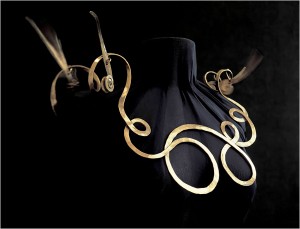
It makes sense that the man who invented the mobile would make interesting jewelry, since both involve movement and three dimensions. “Like many artists, especially sculptors, jewelry served as a model, almost, for larger pieces,” says Toni Greenbaum, a specialist in Modernist jewelry. “That was certainly true of Calder.” (More on Alexander Calder’s jewelry here.)
Gloria Leiberman, director of Skinner’s jewelry department, has sold jewelry by Picasso and Ernst, as well the French painter André Derian, “They were all very similar: plaques and faces,” she says. “They were all trying their hands, but they were not jewelers. They were painters and sculptors. I think that their jewelry is very interesting to the collector of works by those artists but not as beautiful pieces of jewelry.”
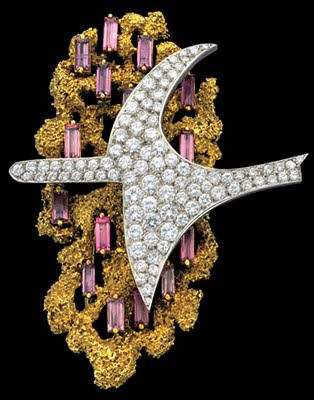
Greenbaum points out, however, that the goldsmith-made work still bears the mark of the artists who designed it. Picasso, Salvador Dalí and Georges Braque “really worked on their jewelry,” she says. “They worked symbiotically with the artisans who made it. So the hand of the artisan was an extension of the artist. It was only done that way because you need skills to work specific materials. Picasso, Braque and Dalí were not skilled metalsmiths, whereas Calder was.”
Dalí designed some noteworthy surrealistic jewels but also, in later years, a series of commemorative opera medallions that Leiberman describes as “horrible.” (More on Dali’s jewelry here.)
Man Ray was a different story. His twisted gold “lampshade” earrings were famous, photographed once on Catherine Deneuve. Leiberman has sold a few pairs.
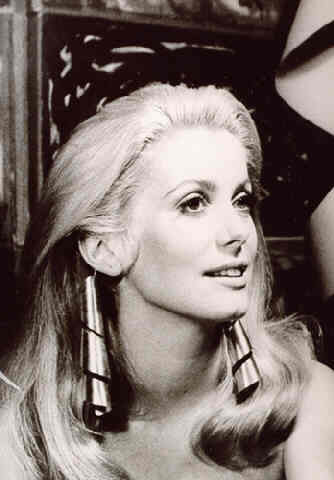
Man Ray, who was also a skilled fashion photographer, produced the chicest jewels of all the celebrity artists. His designs not only reflect his “serious” art but also drew dramatic attention to the women who wore them. He designed most of it in the early 1970s, scouring his entire portfolio for inspiration. Hints of drawings and sculptures dating to 1930 appear in his jewelry. Produced by Milan’s Gem Montibello in editions of 12, wearable Man Rays include a huge 24k gold pendant of a female profile with lapis eyes based on a 1961 drawing and an eye-shaped brooch of 18k green and red gold and malachite based on a object he made in 1944.
Gem Montebello, which produced designs by Man Ray, had a reputation for turning out some of the most fascinating and imaginative artist-made jewelry during this period. Gian Carlo Montebello founded this workshop in 1967 with the purpose of collaborating with artists of international reputation. Many of the world’s top artists took him up on his offer to produce their designs using some of Europe’s most highly-skilled goldsmiths.
One of them was sculptor Niki de Saint Phalle, who designed the fountain in front of the Pompadou Center in Paris. Like Man Ray, she produced red and green gold pieces through Gem Montebello, but hers were flamboyantly shaped and enameled. Belgian sculptor Pol Bury created amazing kinetic jewelry in collaboration with Gem Montebello, earrings and pendants with tiny moving filaments that look like something viewed through a microscope in a biology lab.
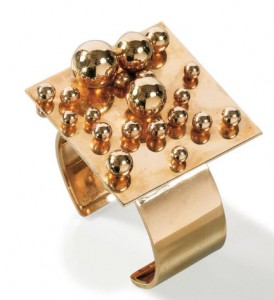
These artists certainly didn’t invent art jewelry. The turn-of-the-century decorative artists of the Arts and Crafts and Art Nouveau movements—particularly René Lalique—can be credited with that. But the paintings and sculpture of Picasso, Dalí and Braque definitely influenced mid-century Modernist studio jewelry, as did Cubism, Abstract Expressionism and Surrealism. “What Picasso and Man Ray were doing in the middle of the century was entirely separate from Modernist jewelry being made by studio jewelry artists,” says gallerist Helen Drutt English, whose post-1960 studio jewelry collection is now at the Houston Museum of Fine Arts.
But Picasso and Man Ray brought new respect to jewelry as an art form. “They lent it relevance,” says Leiberman. “This was a body of work by well-established artists, not jewelers.” Some would also say they paved the way for celebrity jewelry designers, Picasso’s granddaughter Paloma being one. “Paloma is still mainstream jewelry,” Leiberman says. “If her name wasn’t Picasso and she wasn’t working for Tiffany, I don’t know. It makes people think, ‘Oh, we have artist-designed jewelry.’ ”
One thing is certain: Artist-designed jewelry found a ready audience in the ’60s and ’70s. Though most of the artists who created it are either dead or no longer making jewelry, as Leiberman observes, “the artist-designed jewelry trend uncovered a niche in the market.” To some degree, that niche turned into a demand for both big-name designers and unique, self-expressive jewelry—and it’s been growing ever since.

